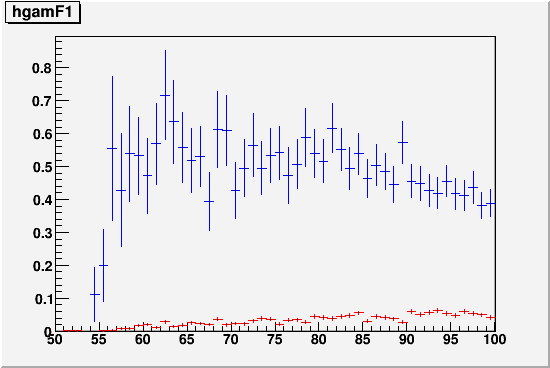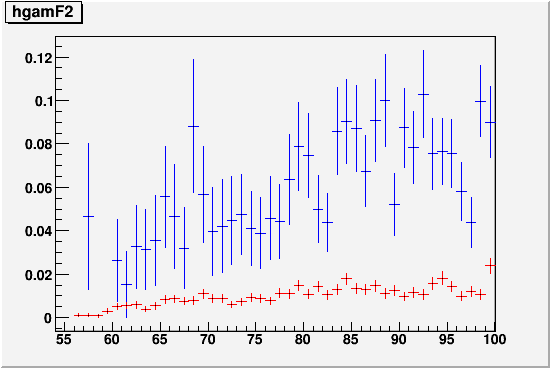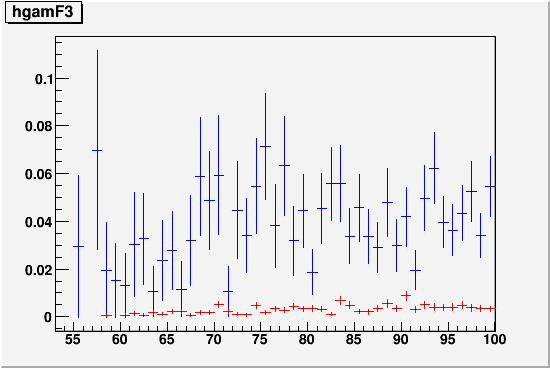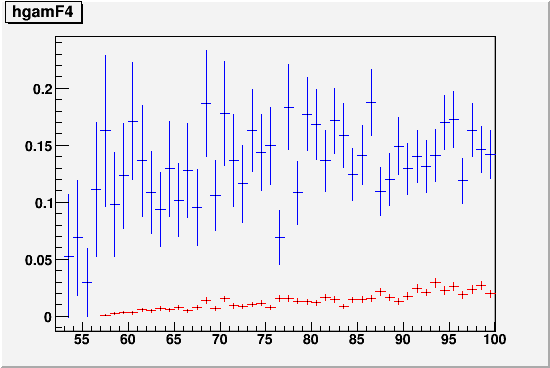- leun's home page
- Posts
- 2013
- 2012
- December (2)
- October (3)
- September (2)
- August (1)
- July (4)
- June (4)
- May (2)
- April (3)
- March (5)
- February (5)
- January (5)
- 2011
- December (3)
- November (3)
- September (5)
- August (2)
- July (2)
- June (3)
- May (4)
- April (4)
- March (2)
- February (4)
- January (2)
- 2010
- December (2)
- November (3)
- October (3)
- September (5)
- August (6)
- July (2)
- June (4)
- May (3)
- April (4)
- March (4)
- February (2)
- January (4)
- 2009
- 2008
- October (1)
- My blog
- Post new blog entry
- All blogs
Single Photon Splitting Filter
Single Photon Splitting Filter
When the reconstruction splits a photon into two, it tends to leave signatures in various kinematic variables. We've already seen that to large extent, the split single photon produces two mass peaks that can be separated by Zgg and Dgg. Building on this, the Single Photon Splitting Fiilter looks at 4 diffferent regions of Zgg, and for each region identifies a peak in the Mgg-Dgg space that is characteristic to split photons.
In data analysis, photon pairs identified as coming from split photons are then merged at the photon list level, and included in the analysis with number of photons reduced by one. Since our interest is to keep these events, it is necessary to look at events with Zgg>0.7. That is, the usual Zgg cut comes in after the merging of potential split photon is done.
NOTE: Adding digitization and noise did not alter the split photon signatures significantly, apart from making the peaks a bit more fuzzy. The exception was filter 3, which changed somewhat, but that one plays the least important role of the four.
For all following 2-panel plots, the left hand side panel is for split single photons, and the right hand side panel is for normal pi0s. They are intended to illustrate the effect(catching split photons) and side effect(merging real pi0s).
Filter 1. Z<0.75
Fig 1. Mgg vs. Dgg. Boxed area indicates the filtered region.

In fact, the Dgg cut varies slightly as a function of energy.
Fig.2 Dgg vs. Thrown energy, with lines indicating the range of Dgg filter.

Fig.3 Probability for the Splitting FIlter to catch split photons (Blue) and to merge real pi0s into fake single photons. (Red)

Filter 2. Z>0.75 and Z<0.95
Fig 4. Mgg vs. Dgg. Boxed area indicates the filtered region.

In fact, the Dgg cut varies slightly as a function of energy.
Fig.5 Dgg vs. Thrown energy, with lines indicating the range of Dgg filter.

Fig.6 Probability for the Splitting FIlter to catch split photons (Blue) and to merge real pi0s into fake single photons. (Red)

Filter 3. Z>0.95 and Z<0.99
Fig 7. Mgg vs. Dgg. Boxed area indicates the filtered region. Dgg cut is fixed for this filter.

Fig.8 Probability for the Splitting FIlter to catch split photons (Blue) and to merge real pi0s into fake single photons. (Red)

Filter 4. Z>0.99
Fig 9. Mgg vs. Dgg. There is no further cut for filter 4. All events with Zgg>0.99 are considered split photons.

Fig.10 Probability for the Splitting FIlter to catch split photons (Blue) and to merge real pi0s into fake single photons. (Red)

The sum of all 4 filters produces the following filter rate.
Fig.11 Total probability for the Splitting FIlter to catch split photons (Blue) and to merge real pi0s into fake single photons. (Red)

- leun's blog
- Login or register to post comments
